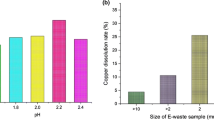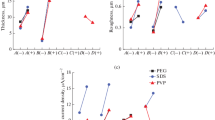Abstract
An electrochemical approach to decreasing high levels of total organic carbon (TOC) in printed circuit board (PCB) copper sulfate plating baths has been investigated. The organic contaminants build-up over the course of pattern plating of PCBs, and at high concentrations they interfere with the quality of the plated copper. The electrochemical approach involves destroying the organic contaminants using electrochemical oxidation. Various anode materials (glassy carbon, lead, lead dioxide, platinum, iridium dioxide and doped tin dioxide) were screened for this application. Some corrosion data is presented for these anodes and their performance for TOC removal at various current densities has been roughly quantified using an apparent first order rate constant. The three best performing anode materials gave increasing oxidation rates going from platinum to doped tin dioxide to lead dioxide, unfortunately anode stability decreased in the same order.
Similar content being viewed by others
References
C.F. Coombs, Jr (Ed.), ‘Printed Circuits Handbook’ (McGraw-Hill, New York, 3rd edn, 1988) pp. 12.16–12.17.
J.A. Scarlett, ‘The Multilayer Printer Circuit Handbook’ (Electrochemical Publications, Ayr, Scotland, 1985), pp. 339–340.
J.A. Wojtowicz, ‘Ozone generation’, in ‘Kirk-Othmer Encyclopedia of Chemical Technology Online’ (J. Wiley & Sons, New York, 1996).
M. Katoh, Y. Nishiki and S. Nakamatsu, J. Appl. Electrochem. 24 (1994) 489.
M. Pourbaix, ‘Atlas of Electrochemical Equilibria in Aqueous Solutions', (NACE, Houston, TX, 2nd edn, 1974).
R. Rasiyah and A.C.C. Tseung, J. Electrochem. Soc. 131 (4) (1984)803.
Ch. Comninellis, Electrochim. Acta 39 (11/12) (1994) 1857.
B. Fleszar and J. Ploszynska, Electrochim. Acta 30 (1) (1985) 31.
B.E. Conway and T.C. Liu, Proc. R. Soc. Lond. A 429 (1990) 375–397.
J.J. Kaczur and D.W. Cawlfield, US Patent 5 294 319 (1994).
Ch. Comninellis and C. Pulgarin, J. Appl. Electrochem. 21 (1991)703.
R.B. Bird, W.E. Stewart and E.N. Lightfoot, ‘Transport Phenomena’ (J. Wiley & Sons, New York, 1960), pp. 390–394 and 465–467.
J.D. Rodgers, W. Jedral and N.J. Bunce, Environ. Sci. Technol. 33(9) (1999) 1453.
J.J. Dietrich, US Patent 5 364 509 (1994).
R. Kotz, C. Schuler and S. Stuki, US Patent 4 839 007 (1989).
B. Correa-Lozano, Ch. Comninellis and A. De Battisti, J. Appl.Electrochem. 27 (1997) 970.
L. Lipp and D. Pletcher, Electrochim. Acta 42 (7) (1997) 1091–1099.
C. Terrier, J.P. Chatelon, J.A. Roger, R. Berjoan and C. Dubois, J. Sol-Gel Sci. Tech. 10 (1007) 75–81.
D.R. Pyke, R. Reid and R.J.D. Tilley, J.C.S. Faraday I 76 (1980) 1174–1182.
A. Messad, J. Bruneaux, H. Cachet and M. Froment, J. Mater.Sci. 29 (1994) 5095.
I-H. Yea, S. Kim, R. Jacobson and D.C. Johnson, J. Electrochem.Soc. 136 (5) (1989) 1395.
N.D. Popovic, J.A. Cox and D.C. Johnson, J. Electroanal. Chem. 456 (1998) 203.
Ch. Comninellis and E. Plattner, J. Appl. Electrochem. 12 (1982)399.
T.H. Jeffers and R.D. Groves, ‘Minimizing lead contamination in copper produced by solvent extraction-electrowinning', US Department of the Interior, Bureau of Mines Report of Investigations, No. 8934 (1985).
W.M. Tuddenham and P.A. Dougall in‘Kirk-Othmer Encyclopedia of Chemical Technology’, Vol. 6 (J. Wiley & Sons, New York, 3rd edn, 1979), pp. 858–869.
P.T. Ford, Printed Circuit Fabrication, Aug. (1985) 30.
O. Simond and Ch. Comninellis, Electrochim. Acta 42 (1997) 2013. 968.
Author information
Authors and Affiliations
Rights and permissions
About this article
Cite this article
Gattrell, M., MacDougall, B., Henuset, Y. et al. An electrochemical approach to total organic carbon control in printed circuit board copper sulfate plating baths Part I: Anode performances. Journal of Applied Electrochemistry 32, 961–968 (2002). https://doi.org/10.1023/A:1020941021354
Issue Date:
DOI: https://doi.org/10.1023/A:1020941021354




